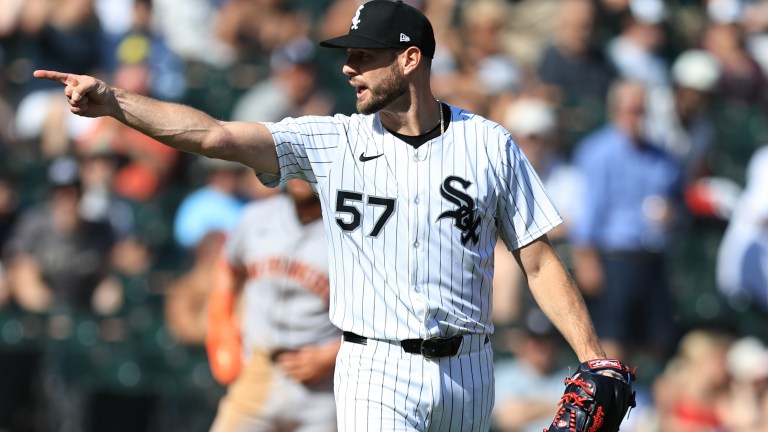Adrian Houser Gives the White Sox an Improbable Trade Chip
As the White Sox prepare for another busy trade deadline as full-blown sellers, Adrian Houser's random and improbable turnaround has made him one of their top trade chips.

When you take a look at pitching leaderboards from the 20th of May to today, most of the top ten names are the usual suspects. You’ve got Ranger Suarez, Paul Skenes, Framber Valdez, Tarik Skubal, Zack Wheeler, Andrew Abbott, ADRIAN HOUSER, Jacob deGrom, Yusei Kikuchi, and Clarke Schmidt taking up the spots.
Sure, Abbott is a bit of a deep cut and a new entrant to lists like this. But by now, he’s 14 starts into his season and he’s looking more legitimate every single time he takes the mound.
But Houser, who sports MLB’s seventh-best ERA dating back to May 20 (his first start of the season), is one that absolutely nobody could’ve predicted would go on a run like this.
This is far from Houser’s first go-round at the game’s highest level. In fact, he debuted 10 years ago as a 22-year-old for the Milwaukee Brewers. He’s bounced around a bit in recent years, but the right-hander hasn’t been anywhere near as valuable as he’s been this year since back in 2021.
When the Chicago White Sox brought Houser aboard, it’s unlikely they predicted he’d be shoving like this through his first handful of starts on the team. No, they probably were looking for a warm body who could eat innings and potentially turn into a tradeable asset come this season’s deadline.
Instead, Houser’s one of the top trade chips on this team. Let’s take a closer look at what he’s got going on as a member of the White Sox, and why he’s suddenly looking like a player that could net Chicago a halfway decent package.
Adrian Houser Is a Random But Valuable Trade Chip
There’s not a whole lot in Houser’s game that’s flashy. He’s not going to blow you away with triple-digit heat, he barely strikes anyone out and typically does little more than eat innings and post mid-4.00 earned run averages on an annual basis.
Houser uses a five-pitch mix to keep hitters off balance and has used each of them to help him surrender no less than three earned runs in any of his big league starts this year. He’s gone no less than five innings in any of his outings and he’s fresh off of a scoreless seven-inning start against the San Francisco Giants in what was his longest outing of the year.
Houser reportedly worked at PitchingWRX, a training facility ran by former White Sox pitcher Lane Ramsey, this past offseason. There, Houser added a few ticks to his fastball’s velocity (92.8 last year, 94.2 this year) and increased his overall arm strength to help his existing stuff play up a bit. So far, it’s been paying off in a big way for the right-hander.
Batters have had a harder time squaring up Houser’s stuff this year compared to last. In 2024, he was in the 4th percentile in AVG Exit Velocity, 26th in Barrel %, and 2nd in Chase. In those very same categories this year, he’s up to the 63rd, 76th, and 44th percentiles.
By now, you know how this story goes. The White Sox accidentally uncovered a starter who should bring back a respectable package at this year’s trade deadline. Houser, 32, is on an expiring contract and it’d be foolish for the White Sox to hold on to him since they’re already buried in the standings.
That means Houser is practically guaranteed to be on the move in the next month. When he gets dealt, it’ll be the third time in his nine-year career he’s been involved in a trade.
Who Could Use a Starter?
There are a number of contenders who could use a boost to their starting rotation. In the month of June alone, six of the bottom ten starting rotations by ERA are teams that would likely consider themselves playoff hopefuls.
There’s little to no shot Houser is going to command a major prospect haul at the deadline, but the more innings he has under his belt with the results he’s been getting, the higher value the White Sox can get for him.
Chicago Cubs
Justin Steele is out for the year, Shota Imanaga has had an injury-shortened campaign, and three of the current five starters in the Cubs’ rotation have been so-so this season. Matthew Boyd has been outstanding as the club’s newfound “ace”, but the need for an additional arm couldn’t be more obvious.
The Cubs are 23rd in starter’s ERA as of right now. For a team hoping to bring home a postseason berth, this doesn’t feel like something they’ll be able to keep up if they want to make a deep run through the playoffs.
In the month of June alone, Chicago’s starters were also 23rd in ERA at 4.77. Their FIP of 5.00 was 28th in the game and each of Jameson Taillon, Cade Horton, Colin Rea, and Ben Brown posted an ERA north of 5.47. The team has a three-game advantage over the Milwaukee Brewers in the NL Central standings, but things need to change in that starting rotation.
Houston Astros
Down in Houston, Hunter Brown and Framber Valdez form what could very well be MLB’s best one-two punch atop any starting rotation.
Outside of Brown and Valdez, the Astros have relied upon unproven commodities like Colton Gordon, Brandon Walter, Ryan Gusto, as well as oft-injured and still rebounding Lance McCullers Jr. With the dynamic duo leading the way, the Astros are sitting pretty, but the need for another arm is apparent.
At 52-34, the Astros have built up a seven-game cushion over the Seattle Mariners in the AL West and they’re as good a bet as any in that division to make a deep postseason run. However, adding a bit more experience to their rotation could go a long way, especially if Houser is able to keep producing the way he has so far.
Not that it makes any difference in trade talks, but Houser was originally drafted in the second round of the 2011 draft by these very same Astros. While it was over a decade ago, the organization was a fan from him when he was first starting out and that ERA starting with a 1 this year will help them be fans of his at 32 years old as well.
Toronto Blue Jays
The Blue Jays were written off by most in the industry before this year’s first pitches were even thrown. Yet, they enter the day tied with the New York Yankees for the top spot in the AL East and they’ve done a great job of staying in the thick of things.
Kevin Gausman, Jose Berrios, and Chris Bassitt have all been worth 1.4 fWAR or higher, but they’ve also been prone to the occasional blowup start. As a matter of fact, Gausman gave up seven earned runs three starts ago, Berrios gave up six his last time out, and Bassitt gave up eight in his last start.
Behind this trio, the Blue Jays have used random breakout star Eric Lauer and oft-injured Max Scherzer to round out their starting-five. This group has combined to rank just 26th in the league in starter’s ERA (4.67), which is quite a difference from the 3.95 mark they had last year that landed them in the 14th spot.
Lauer and Houser might throw with opposite hands, but they’ve got similar makeups. Both have bounced around a bit and are experiencing some impressive turnarounds on their new teams. It remains to be seen if Lauer can keep his own hot stretch up, but Houser could be a nice replacement for either the left-hander or Scherzer if he needs to go back on the shelf.
Bowden Francis has struggled this year and Alek Manoah isn’t due back for a few months yet. The Blue Jays have done an impressive job staying afloat in the standings, but some additional reinforcements would be immensely helpful. Houser won’t break the bank either, so Toronto shouldn’t have to dig too deep into a weak (but improving!) farm system for this one.
One of Many Pieces The White Sox Should Move
The White Sox are said to be willing to eat some money on Andrew Benintendi’s remaining contract if there were any teams brave enough to take him on at this year’s deadline. He could be moved, but his contract and the fact that he hasn’t been a consistently above-average player in years makes it feels unlikely he goes anywhere.
Still, the White Sox would undoubtedly love to move him. Luis Robert Jr. is another decent trade chip who has value to bring to the table but is made of glass and struggles with his own inconsistencies on the diamond.
Pure rental position players include outfielders Michael A. Taylor and Austin Slater, while Josh Rojas and Mike Tauchman have an additional year available through arbitration but both have their own respective values as trade chips.
Outside of Houser, the newly acquired Aaron Civale and left-handers Tyler Alexander and Martin Perez (mutual option) should all hit the open market at season’s end as well.
For those keeping count at home, that’s six players on expiring contracts and a few controllable assets who could be moved as well. The White Sox are gearing up for what could (should, really…) be an eventful deadline. They’ve got some promising young pieces in place for the other side of this rebuild, but they still need to be in future-building mode at this year’s deadline. Houser’s value should be higher than most, if not all, of the club’s tradeable assets.
